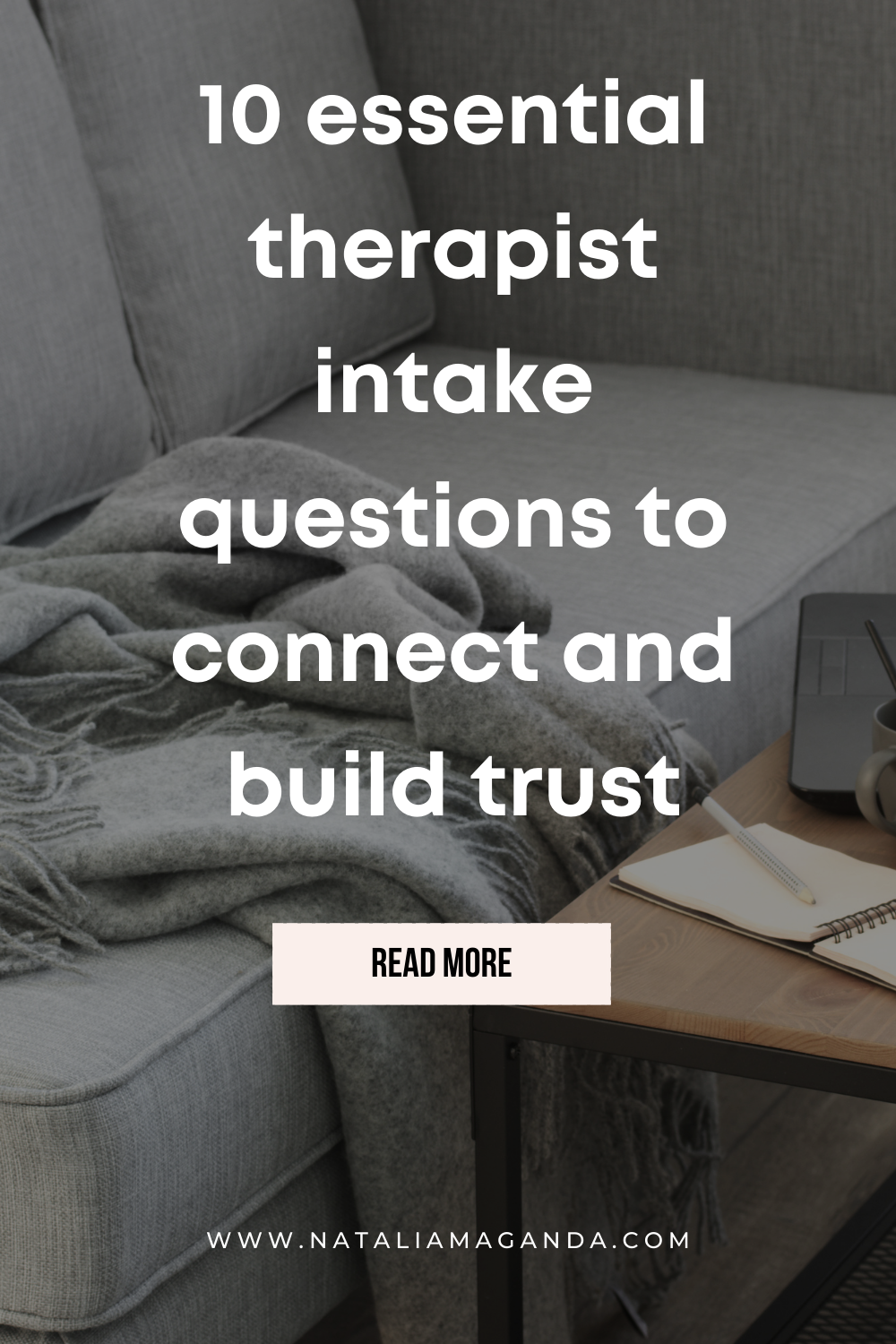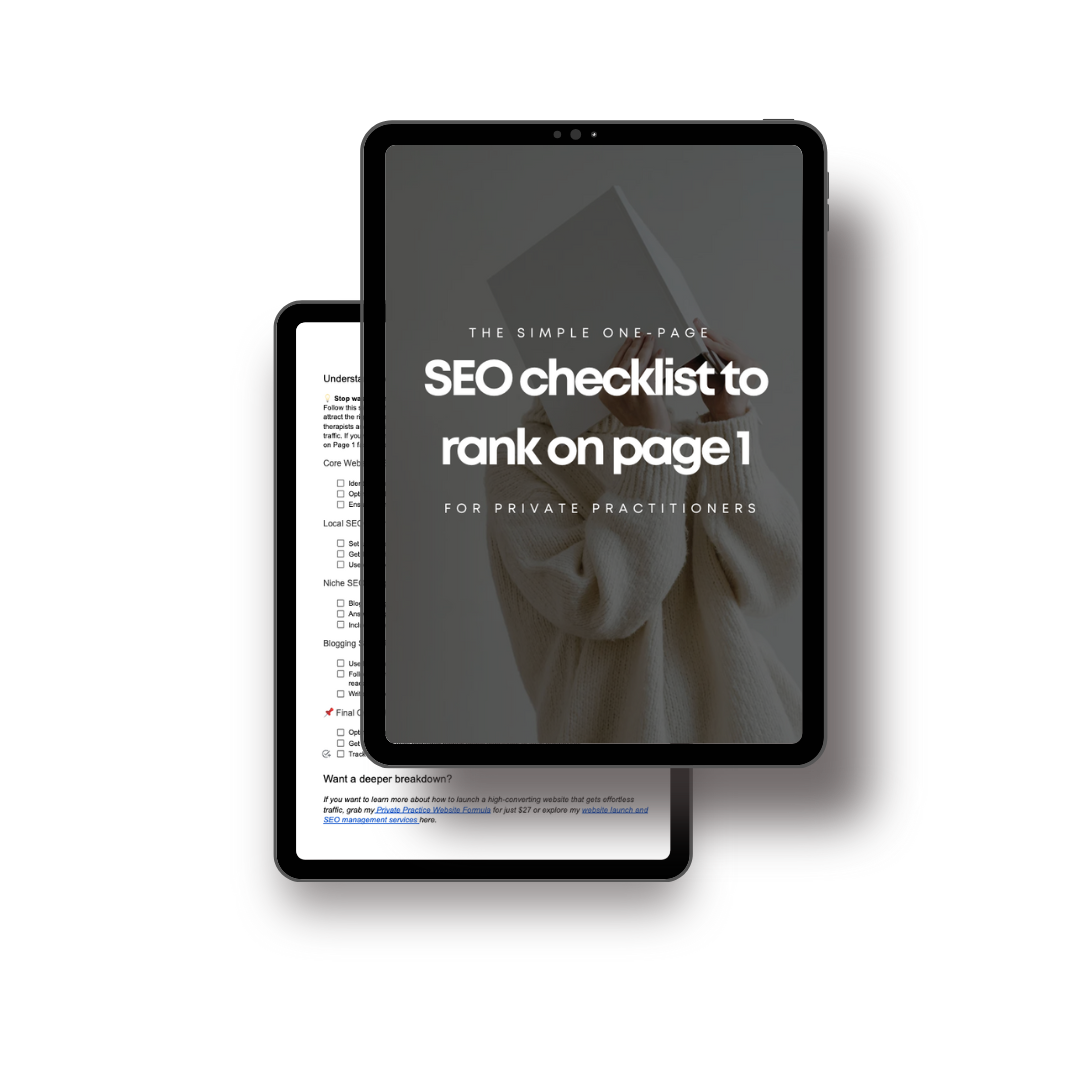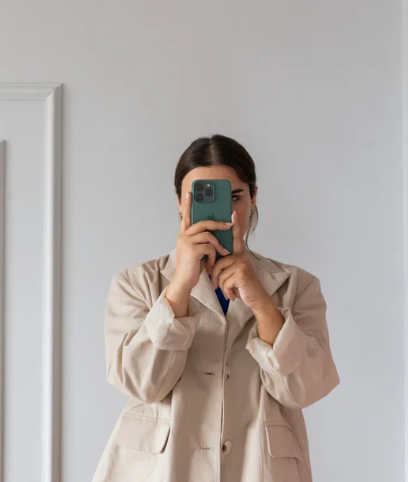10 essential therapist intake questions to connect and build trust
Your intake process is your first shot at showing your clients, “Hey, I get you, and I’m here to help.” It’s like your practice’s opening line at a party—except instead of small talk, you’re setting the stage for a transformational relationship.
If your current intake process feels stiff or outdated, don’t stress. I’ve got your back! In this post, we’ll craft intake questions that do the heavy lifting for you: attracting the clients you love working with, saving you time, and making your practice the one clients rave about. Ready? Let’s dive in.
Hi there! I’m Natalia Maganda, a website designer for therapists. I help private practice professionals amplify their expertise and attract their ideal clients through strategic web design and clear messaging.
Why therapist intake questions matter
Picture this: A client finally works up the courage to reach out for therapy. They sit down to fill out your form and... crickets. Your intake questions feel vague, cold, or worse—completely irrelevant to their experience. They might still show up, but that moment of connection? Lost.
On the flip side, thoughtfully designed intake questions can:
- Show clients you care and are ready to listen.
- Set you up for a more productive first session (no scrambling for details mid-session!).
- Create a great first impression that makes clients feel, “Yes, this is exactly what I need!”
Your intake process isn’t just paperwork—it’s the first brick in the foundation of trust. Picture this: A client finally works up the courage to reach out for therapy.
*This post contains sponsored links.
The role of a strong intake process in your private practice
Think of your intake process like the first few pages of a novel—it sets the tone for the entire story. If your intake questions are generic or overly clinical, you risk clients feeling like just another number. But when your questions are thoughtful and aligned with your niche, clients feel seen, understood, and ready to dive in.
Here’s why a strong intake process matters:
- It builds trust: Clients know you’re taking them seriously.
- It creates clarity: Both you and your client start with the same expectations.
- It sets the vibe: Are you warm and approachable? Direct and solution-focused? Your intake process reflects your personality.
Example:
Instead of asking, “What are your goals for therapy?” (boring), try, “If we could wave a magic wand, what would life look like after therapy?” This one small change shifts the tone from clinical to compassionate.
10 must-ask therapist intake questions that build connection and trust
Here are 10 thoughtfully crafted therapist intake questions, each designed to foster trust, gather key insights, and set the foundation for a strong therapeutic relationship. Alongside each question, I’ve included the psychology behind why it works to deepen connection and make your sessions more impactful.
1. What motivated you to seek therapy at this time?
Psychology behind it:
This question taps into a client’s sense of urgency and readiness for change. It encourages them to reflect on their immediate concerns and helps you understand the triggering event or situation that brought them to therapy. By acknowledging their current emotional state, you’re validating their experience and setting the tone for empathy and understanding.
2. What’s the one thing you’re struggling with the most right now?
Psychology behind it:
Asking about their most pressing issue helps clients prioritize their concerns. It also reduces overwhelm by narrowing the focus to something tangible. This question signals that you’re ready to meet them where they are, creating a sense of safety and containment.
3. Have you experienced therapy before? If so, what worked well, and what didn’t?
Psychology behind it:
This question allows clients to share past experiences, empowering them to have a voice in their care. It shows that you value their input and are open to tailoring your approach. Positive reinforcement for what worked can create continuity, while learning about negative experiences helps you avoid potential missteps.
4. How do you typically cope with stress or challenges?
Psychology behind it:
Understanding a client’s coping mechanisms provides insight into their resilience and behavioral patterns. Whether their strategies are adaptive (e.g., journaling) or maladaptive (e.g., avoidance), this question offers a starting point for discussions about strengths and areas for growth.
5. Are there any fears or hesitations you have about therapy?
Psychology behind it:
Addressing fears upfront helps normalize the vulnerability that comes with seeking therapy. By openly discussing their concerns, you create a space where they feel safe to voice doubts or apprehensions. This transparency builds trust and reduces barriers to engagement.
6. What would you like to gain or achieve through therapy?
Psychology behind it:
This question helps clients articulate their goals and creates a shared understanding of their desired outcomes. It shifts the focus from problems to possibilities, fostering a sense of hope and agency. It also gives you a roadmap to tailor your interventions.
7. Are there specific situations or triggers you’d like me to be aware of?
Psychology behind it:
This question demonstrates your commitment to creating a safe and supportive environment. Acknowledging triggers allows you to avoid inadvertently causing distress and signals to the client that their emotional safety is a priority.
8. How do you feel supported in your life right now (if at all)?
Psychology behind it:
Exploring their support systems—or lack thereof—helps you gauge their current social and emotional resources. For clients with little support, this question can pave the way for discussions about building stronger networks. For those with existing support, it highlights areas you can reinforce.
9. Are there cultural, spiritual, or personal values that are important for me to know?
Psychology behind it:
This question acknowledges the client’s unique identity and lived experience. By inviting them to share what matters most to them, you demonstrate cultural competence and respect. It also ensures your interventions align with their values and worldview.
10. If you could fast-forward to the end of therapy, what would success look like for you?
Psychology behind it:
This future-focused question encourages clients to envision their ideal outcomes, fostering hope and motivation. It also gives you insight into what matters most to them, helping you create a collaborative plan to reach those goals. This visualization can be a powerful tool for building connection and commitment.
Why these questions matter
Each of these questions is designed to go beyond surface-level information, helping you connect with your clients on a deeper level while gathering the practical details you need to guide their care. By weaving empathy and intentionality into your intake process, you can make clients feel seen, heard, and supported from the start.
FAQs about therapist intake questions
How long should my intake form be?
Short enough that it doesn’t feel like a chore. Aim for 10–15 questions max. Remember, you can always dive deeper during sessions.
What if a client skips a question?
No big deal! Bring it up casually, like, “I noticed you skipped this—totally fine, but let me know if it’s something you’d like to revisit later.”
Should I tweak questions for returning clients?
Yes! For ongoing clients, focus on progress:
- “What’s changed since our last session?”
- “Are there new goals or challenges you’d like to work on?”
Here’s the truth: even the best intake process won’t mean much if potential clients can’t find—or trust—your website.
Your site should reflect your expertise, your values, and your unique approach to therapy.
If you’re ready to take your practice to the next level, let’s make it happen.Launch your private practice website with a design that not only looks incredible but also does the hard work of attracting your dream clients. Together, we’ll build a site that works as hard as you do!
Related reads therapist marketing:
- How to choose a profitable therapy niche to attract higher-paying clients
- How to make $100K as a therapist without seeing 20+ clients a week
- Private practice therapist salary and tips for increasing your income
- How much is Psychology today? Pros and cons

* AI Disclosure: This content may contain sections generated with AI with the purpose of providing you with condensed helpful and relevant content, however all personal opinions are 100% human made as well as the blog post structure, outline and key takeaways.
* Affiliate Disclosure: Some of the links on www.nataliamaganda.com may contain affiliate links meaning that I will get a commission for recommending products at no extra cost to you.

hello! i'm natalia
Latina, web design expert for mental health professionals.
I help ambitious life coaches, therapists and holistic leaders amplify their magic, gain visibility, and simplify their marketing efforts through strategic web design and content.

The world needs more holistic healing and LIFE coaching
I get to help hundreds of people live their best lives and thrive every time I help people like you, launch a website.

Bilingual strategic web designer for mental health professionals, life coaches & holistic practitioners. We are located in Mexico serving USA & Worldwide. Contact |
All Rights Reserved | Natalia Maganda | Privacy Policy








